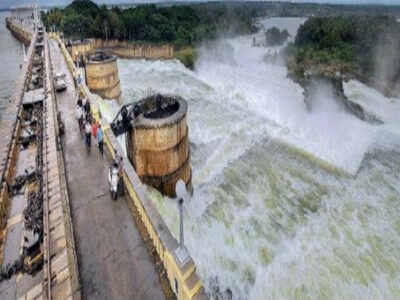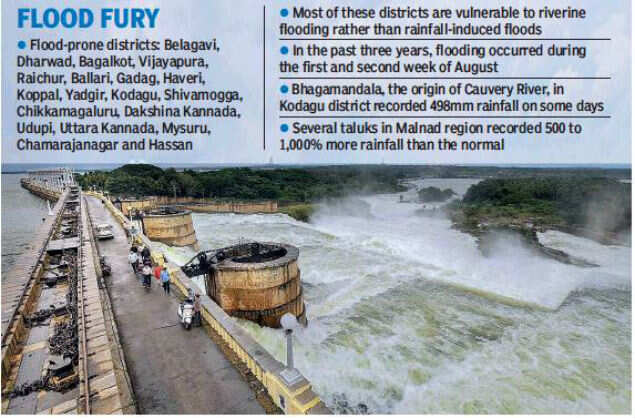
BENGALURU: Sudden discharge from dams brimming with rainwater led to flooding in large parts of Karnataka last year. The deluge claimed more than 200 lives, damaged crops on 30 lakh hectares of farmland and displaced 3 lakh people.
The devastation and hard lessons prompted the state government to improve weather monitoring and dam management, and the efforts, especially steady water discharge at intervals, have produced results this year. Compared to 2019, only 42 deaths have been recorded this monsoon season. Crops on 4 lakh hectares suffered damage.

“Despite the Covid-19 crisis, we started preparing for the southwest monsoon in April. We adopted a three-pronged strategy to prevent floods because of incessant, high-intensity rainfall and high discharge from reservoirs in Krishna and Cauvery basins,” said Manoj Rajan, commissioner of the Karnataka State Disaster Management Authority (KSDMA). An integrated dam management mechanism was put in place in coordination with Maharashtra and Kerala. Water release from reservoirs was regulated by taking into account rainfall forecast, possible inflows into the dams and the carrying capacity of rivers downstream.
“This helped reduce flooding in villages along the river banks. Updates and alerts on dam water release were given well in advance to villages through a new flood forecast cell. Also, water was released at frequent intervals,” Rajan explained. The cell obtained weather forecast from the Space Applications Centre in Ahmedabad and from 7,000 monitoring stations in the state. For the first time, 912 gram panchayats in 13 districts that are vulnerable to floods were identified and an emergency preparedness plan, involving relief camps and other steps, was drawn up.
“We also pre-positioned NDRF, SDRF, fire and emergency services teams in flood-prone districts. Apart from this, four IAF helicopters were kept on standby for search and rescue operations,” Rajan said. Last year, the state received record rainfall and discharge in reservoirs was above 7 lakh cusecs for a long period, which led to flash floods. This time, the intensity of floods was less, though some other weather conditions were severe. Wind speeds, for instance, were two to three times higher than normal.
According to KSDMA data, 10,978 houses were damaged this year. Of these, 2,893 collapsed or suffered extensive damage.
The devastation and hard lessons prompted the state government to improve weather monitoring and dam management, and the efforts, especially steady water discharge at intervals, have produced results this year. Compared to 2019, only 42 deaths have been recorded this monsoon season. Crops on 4 lakh hectares suffered damage.

“Despite the Covid-19 crisis, we started preparing for the southwest monsoon in April. We adopted a three-pronged strategy to prevent floods because of incessant, high-intensity rainfall and high discharge from reservoirs in Krishna and Cauvery basins,” said Manoj Rajan, commissioner of the Karnataka State Disaster Management Authority (KSDMA). An integrated dam management mechanism was put in place in coordination with Maharashtra and Kerala. Water release from reservoirs was regulated by taking into account rainfall forecast, possible inflows into the dams and the carrying capacity of rivers downstream.
“This helped reduce flooding in villages along the river banks. Updates and alerts on dam water release were given well in advance to villages through a new flood forecast cell. Also, water was released at frequent intervals,” Rajan explained. The cell obtained weather forecast from the Space Applications Centre in Ahmedabad and from 7,000 monitoring stations in the state. For the first time, 912 gram panchayats in 13 districts that are vulnerable to floods were identified and an emergency preparedness plan, involving relief camps and other steps, was drawn up.
“We also pre-positioned NDRF, SDRF, fire and emergency services teams in flood-prone districts. Apart from this, four IAF helicopters were kept on standby for search and rescue operations,” Rajan said. Last year, the state received record rainfall and discharge in reservoirs was above 7 lakh cusecs for a long period, which led to flash floods. This time, the intensity of floods was less, though some other weather conditions were severe. Wind speeds, for instance, were two to three times higher than normal.
According to KSDMA data, 10,978 houses were damaged this year. Of these, 2,893 collapsed or suffered extensive damage.

Coronavirus outbreak
Trending Topics
LATEST VIDEOS
City
 Shocking: Retired Army doctor stabs husband to death in Hyderabad
Shocking: Retired Army doctor stabs husband to death in Hyderabad  'Y' category security to Kangana Ranaut: 'Will Dawood also be given security?' asks Shiv Sena leader Pratap Sarnaik
'Y' category security to Kangana Ranaut: 'Will Dawood also be given security?' asks Shiv Sena leader Pratap Sarnaik  Sushant was not a drug addict; was given heavy dosage of medicines by Rhea, alleges a friend
Sushant was not a drug addict; was given heavy dosage of medicines by Rhea, alleges a friend  ICICI-Videocon case: Chanda Kochhar's husband arrested by ED over money laundering allegations
ICICI-Videocon case: Chanda Kochhar's husband arrested by ED over money laundering allegations
More from TOI
Navbharat Times
Featured Today in Travel
Get the app





